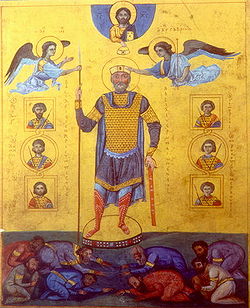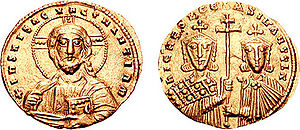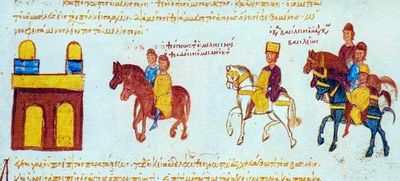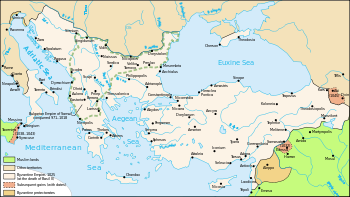Basil II
| Basil II (Βασίλειος Β' ο Βουλγαροκτόνος) | |
|---|---|
| Emperor of the Byzantine Empire | |
 |
|
| Reign | nominally from 960 (as co-emperor), effectively 10 January 976 – 15 December 1025 |
| Born | 958 |
| Died | 15 December 1025 (aged 67) |
| Predecessor | John I Tzimiskes |
| Successor | Constantine VIII |
| Dynasty | Macedonian dynasty |
| Father | Romanos II |
| Mother | Theophano |
Basil II, later surnamed the Bulgar-slayer (Greek: Βασίλειος Β΄ Βουλγαροκτόνος, Basileios II Boulgaroktonos, Bulgarian: Василий II Българоубиец. 958 – December 15, 1025), known in his time as Basil the Porphyrogenitus and Basil the Young to distinguish him from his ancestor Basil I the Macedonian, was a Byzantine emperor from the Macedonian dynasty who reigned from 10 January 976 to 15 December 1025.
The first part of his long reign was dominated by civil war against powerful generals from the Anatolian aristocracy. Following their submission, Basil oversaw the stabilization and expansion of the Byzantine Empire's eastern frontier, and above all, the final and complete subjugation of Bulgaria, the Empire's foremost European foe, after a prolonged struggle. He acknowledged regal title and also promoted Stjepan Držislav of Croatia to a Patriarch and an Exarch of Dalmatia and Croatia, after Držislav helped him against Tsar Samuil of Bulgaria. At his death, the Empire stretched from Southern Italy to the Caucasus and from the Danube to the borders of Palestine, its greatest territorial extent since the Muslim conquests, four centuries earlier.
Despite near-constant warfare, Basil also showed himself a capable administrator, reducing the power of the great land-owning families who dominated the Empire's administration and military, and filling the Empire's treasury. Of far-reaching importance was Basil's decision to offer the hand of his sister Anna to Vladimir I of Kiev[1] in exchange for military support, which led to the Christianization of the Kievan Rus', and the incorporation of Russia within the Byzantine cultural sphere.
Contents |
Birth and childhood
Basil was the son of Emperor Romanos II by Theophano, whose family was of Laconian Greek origin[2][3][4][5][6][7] originating in the Peloponnesian region of Lakonia[8], possibly from the city of Sparta[9]. In 960, he was associated on the throne by his father, but the latter died in 963, when Basil was only five years old. Because he and his brother, the future Emperor Constantine VIII (ruled 1025–1028), were too young to reign in their own right, Basil's mother Theophano married one of Romanos' leading generals, who took the throne as the Emperor Nikephoros II Phokas several months later in 963. Nikephoros was murdered in 969 by his nephew John I Tzimisces, who then became emperor and reigned for seven years. Finally, when John died on January 10, 976, Basil II took the throne as senior emperor.
Asian rebellions and alliance with Rus'
Basil was a brave soldier and a superb horseman; he was to prove himself a strong ruler and an able general. He did not at first display the full extent of his energy. In the early years of his reign, the administration remained in the hands of the eunuch Basil Lekapenos (an illegitimate son of Emperor Romanos I), president of the senate, a wily and gifted man, who hoped that the young emperors would be his puppets. Basil waited and watched without interfering, and devoted himself to learning the details of administrative business and instructing himself in military science.
Even though Nikephoros II Phokas and John I Tzimiskes were brilliant military commanders, both had proven to be lax administrators. Towards the end of his reign John had belatedly planned to curb the power of the great landowners, and his death, coming soon after his speaking out against them, led to rumours that he had been poisoned by Basil Lekapenos, who had acquired vast estates illegally and feared an investigation and punishment.
As a result of the failures of his immediate predecessors Basil II found himself with a serious problem at the very outset of his effective reign as two members of the wealthy military elite of Anatolia, Bardas Skleros and Bardas Phokas, had sufficient means to undertake open rebellion against central authority. The chief motive of these men, both of whom were experienced generals, was that they wished to assume the imperial position that Nikephoros II and John I had held, and thus return Basil to the role of impotent cypher. Basil, showing the penchant for ruthlessness that would become his trademark, took the field himself and suppressed the rebellions of both Skleros (979) and Phokas (989)[10]
These rebellions had a profound effect on Basil's outlook and methods of governance. The historian Psellus describes the defeated Bardas Skleros giving Basil the following advice: "Cut down the governors who become over-proud. Let no generals on campaign have too many resources. Exhaust them with unjust exactions, to keep them busied with their own affairs. Admit no woman to the imperial councils. Be accessible to no one. Share with few your most intimate plans."[11] Basil, it would appear, took this advice very much to heart.
In order to defeat these dangerous revolts, Basil formed an alliance with Prince Vladimir I of Kiev, who in 988 CE had captured Chersonesos, the main imperial base in the Crimea. Vladimir offered to evacuate Chersonesos and to supply 6,000 of his soldiers as reinforcements to Basil. In exchange he demanded to be married to Basil's younger sister Anna (963–1011). At first, Basil hesitated. The Byzantines viewed all the nations of Northern Europe, be they Franks or Slavs, as barbarians. Anna herself objected to marrying a barbarian ruler, as such a marriage would have no precedence in imperial annals.
Vladimir had conducted long-running research into different religions, including sending delegates to various countries. Marriage was not his primary reason for choosing the Orthodox religion. When Vladimir promised to baptize himself and to convert his people to Christianity, Basil finally agreed. Vladimir and Anna were married in the Crimea in 989. The Rus' recruitments were instrumental in ending the rebellion, and they were later organized into the Varangian Guard. This marriage had important long-term implications, marking the beginning of the process by which the Grand Duchy of Moscow many centuries later would proclaim itself "The Third Rome" and claim the political and cultural heritage of the Byzantine Empire.
The fall of Basil Lekapenos followed the rebellions. He was accused of plotting with the rebels and punished with exile and the confiscation of his enormous property. Seeking to protect the lower and middle classes, Basil II made ruthless war upon the system of immense estates which had grown up in Asia Minor and which his predecessor, Romanos I, had endeavored to check.
Campaigns against the Arabs
Having put an end to the internal strife, Basil II then turned his attention to the empire's other enemies. The Byzantine civil wars had weakened the empire's position in the east and the gains of Nikephoros II Phokas and John I Tzimiskes came close to being lost to the Fatimids. Following two heavy defeats of the doux of Antioch, Michael Bourtzes, in 992 and 994, Aleppo was being besieged and Antioch was threatened by the enemy. In 995 Basil II, with an army of 40,000 men (with 80,000 mules)[12], launched a campaign against the Fatimids, relieving Aleppo, taking over the Orontes valley, and raiding further south, sacking all of the cities from Emesa to Tripoli.
Although he did not have sufficient forces to drive into Palestine and reclaim Jerusalem, his victories did restore much of Syria to the empire. No emperor since Heraclius had been able to hold these lands for any length of time, and they remained Byzantine for the next 75 years.
Byzantine conquest of Bulgaria

Basil also wanted to restore to the empire territories that it had long lost. At the start of the second millennium, he took on his greatest adversary, Samuel of Bulgaria. Bulgaria had been partly subjugated by John I Tzimiskes, but parts of the country had remained outside Byzantine control, under the leadership of Samuel and his brothers.
Since the Bulgars had been raiding Byzantine lands since 976, the Byzantine government sought to cause dissention amongst them by first allowing the escape of their captive emperor Boris II of Bulgaria.
This having failed, Basil used a respite from his conflict with the nobility to lead an army of 30,000 men into Bulgaria and besiege Sredets (Sofia) in 986. Taking losses and worried about the loyalty of some of his governors, Basil lifted the siege and headed back for Thrace but fell into an ambush and suffered a serious defeat at the Battle of the Gates of Trajan.
Basil escaped with the help of his Varangian Guard and attempted to make up his losses by turning Samuel's brother Aaron against him. Aaron was tempted with Basil's offer of his own sister Anna in marriage (the same Anna wed to Vladimir I of Kiev, two years later), but the negotiations failed when Aaron discovered that the bride he was sent was a fake.
By 987 Aaron had been eliminated by Samuel, and Basil was busy fighting both Skleros and Phokas in Asia Minor. Although the titular emperor Roman of Bulgaria was captured in 991, Basil lost Moesia to the Bulgarians.
In 992, Basil II concluded a treaty with Pietro Orseolo II by the terms that Venice's custom duties in Constantinople would be reduced from 30 nomismata to 17 nomismata in return for the Venetians agreeing to transport Byzantine troops to southern Italy in times of war.[13]

In the years of Basil's distraction with internal rebellions and recovering the military situation on his eastern frontier Samuel had extended his rule from the Adriatic Sea to the Black Sea, recovering most of the lands which had been Bulgarian before the invasion of Svyatoslav I of Kiev. He also conducted damaging raids into Byzantine territory as far as central Greece. The turning of the tide of the conflict occurred in 996 when the Byzantine general Nikephoros Ouranos inflicted a crushing defeat on a raiding Bulgarian army at a battle on the River Spercheios (Sperchius) in Thessaly. Samuel and his son Gabriel were lucky to escape capture.[14]
From 1000, Basil II was free to focus on a war of outright conquest against Bulgaria, a war he prosecuted with grinding persistence and strategic insight. In 1000 the Byzantine generals Nikephoros Xiphias and Theodorokan took the old Bulgarian capital of Great Preslav, and the towns of Lesser Preslav and Pliskova.[15] In 1001 Basil himself, his army operating from Thessalonica, was able to regain control of Vodena, Verrhoia and Servia.[16] The following year Basil based his army in Philippopolis and occupied the length of the military road from the western Haemus Mountains to the Danube, thereby cutting off Samuel's communications between his Macedonian heartland and Moesia. Following up this success he laid siege to Vidin, which eventually fell following a prolonged resistance.[17] Samuel reacted to the Byzantine campaign with a daring stroke; he launched a large-scale raid into the heart of Byzantine Thrace and surprised the major city of Adrianople. On returning homeward with his extensive plunder Samuel was intercepted near the town of Skopje by a Byzantine army commanded by the emperor. Basil's forces stormed the Bulgarian camp, inflicting a severe defeat on the Bulgarians and recovering the plunder of Adrianople. Skopje surrendered shortly after the battle; its governor, Romanos, was treated with overt kindness by the emperor.[18] In 1005, the governor of Durazzo, Ashot Taronites, surrendered his city to the Byzantines. The defection of Durazzo to the Byzantines completed the isolation of Samuel's core territories in the highlands of western Macedonia. Samuel was forced into an almost entirely defensive stance and he extensively fortified the passes and routes from the Byzantine held coastlands and valleys into the territory remaining in his possession. During the next few years, the Byzantine offensive slowed and no significant gains were made, though in 1009 an attempt by the Bulgarians to counterattack was defeated at the Battle of Kreta, which was fought to the east of Thessalonica.
In 1014 Basil was ready to launch a campaign aimed at destroying Bulgarian resistance. On July 29, 1014, Basil II and his general Nikephoros Xiphias outmanoeuvred the Bulgarian army, which was defending one of the fortified passes, in the Battle of Kleidion. Samuel avoided capture only through the valour of his son Gabriel. Having crushed the Bulgarians, Basil was said to have captured 15,000 prisoners and blinded 99 of every 100 men, leaving 150 one-eyed men to lead them back to their ruler. Samuel was physically struck down by the dreadful apparition of his blinded army, and he died two days later after suffering a stroke. Although the extent of Basil's mistreatment of the Bulgarian prisoners may have been exaggerated, this incident helped to give rise to Basil's nickname of Boulgaroktonos, "the Bulgar-slayer", in later tradition.[19].
Bulgaria fought on for four more years, its resistance fired by Basil's cruelty, but it finally submitted in 1018. This submission was the result of continued military pressure and a successful diplomatic campaign aimed at dividing and suborning the Bulgarian leadership. This victory over the Bulgarians, and the later submission of the Serbs, fulfilled one of Basil's goals, as the empire regained its ancient Danubian frontier for the first time in 400 years. Before returning to Constantinople, Basil II celebrated his triumph in Athens. Basil showed considerable statesmanship in his treatment of the defeated Bulgarians; he gave many former Bulgarian leaders court titles, positions in provincial administration, and high commands in the army. In this way he sought to absorb the Bulgarian elite into Byzantine society. Bulgaria did not have a monetary economy to the same extent as was found in Byzantium, and Basil made the wise decision to accept Bulgarian taxes in kind. Basil's successors reversed this policy; a decision which led to considerable Bulgarian discontent, and rebellion, later in the 11th century.
Notwithstanding the above, it was mainly Basil's conspicuous act of cruelty which remained engraved in the historical memory of Greeks and Bulgarians alike, up to and including the 20th Century descendants of both peoples.
Khazar campaign

Although the power of the Khazar Khaganate had been broken by the Kievan Rus' in the 960s, the Byzantines had not been able to fully exploit the power vacuum and restore their dominion over the Crimea and other areas around the Black Sea.
In 1016, Byzantine armies, in conjunction with Mstislav of Chernigov, attacked the Crimea, much of which had fallen under the sway of the Khazar successor kingdom of George Tzoul, based at Kerch. Kedrenos reports that George Tzoul was captured and the Khazar successor-state was destroyed. Subsequently the Byzantines occupied the southern Crimea.
Later years
Basil II returned in triumph to Constantinople, then promptly went east and attacked the Georgian ruler in Tayk, and later secured the annexation of the sub-kingdoms of Armenia (and a promise to have its capital and surrounding regions to be willed to Byzantium following the death of its king Hovhannes-Smbat).[20] Basil created in those highlands a strongly fortified frontier, which, if his successors had been capable, should have proved an effective barrier against the invasions of the Seljuk Turks.
In the meantime, other Byzantine forces restored much of Southern Italy, lost over the previous 150 years, to the empire's control. When Basil finally died on December 15, 1025, he was planning a military expedition to recover the island of Sicily.
Basil was to be buried in the last sarcophagus available in the rotunda of Constantine I in the Church of the Holy Apostles. However, he later asked his brother and successor Constantine VIII to be buried in the Church of St. John the Theologian (i.e. the Evangelist), at the Hebdomon Palace complex, outside the walls of Constantinople. The epitaph on the tomb celebrated Basil's campaigns and victories.[1] During the pillage of 1204, Basil's grave was ravaged by the invading Crusaders of the Fourth Crusade.
Assessment

Basil was a stocky man of less than average stature who, nevertheless, cut a majestic figure on horseback. He had light blue eyes and strongly arched eyebrows; in later life his beard became scant but his sidewhiskers were luxuriant and he had a habit of rolling his whiskers between his fingers when deep in thought or angry. He was not a fluent speaker and had a loud laugh which convulsed his whole frame.[21] As a mature man he had ascetic tastes, and cared little for the pomp and ceremony of the imperial court, and typically held court dressed in military regalia. Still, he was a capable administrator, who, uniquely among the soldier-emperors, left a full treasury upon his death.[22] Basil despised literary culture and affected an utter scorn for the learned classes of Byzantium; however, numerous orators and philosophers were active during his reign.[23]
He was worshipped by his army, as he spent most of his reign campaigning with them instead of sending orders from the distant palaces of Constantinople, as had most of his predecessors. He lived the life of a soldier to the point of eating the same daily rations as any other member of the army. He also took the children of deceased officers of his army under his protection, and offered them shelter, food and education. Many of them later became his soldiers and officers, and came to think of him as a father.
Besides being called the "Father of the Army", he was also popular with country farmers. This class produced most of his army's supplies and soldiers. To assure that this continued, Basil's laws protected small agrarian property and lowered their taxes. His reign was considered an era of relative prosperity for the class, despite the almost constant wars. On the other hand, Basil increased the taxes of the nobility and the church and looked to decrease their power and wealth. Though understandably unpopular with them, neither of them had the power to effectively oppose the army-supported Emperor.
Basil never married or had children. As a young man he was a womanizer, but when he became emperor, he chose to devote himself to the duties of state. Psellus ascribes Basil's radical change from a dissolute youth to a grim autocrat to the circumstances of the rebellions of Bardas Skleros and Bardas Phokas.[24] Unfortunately, Basil's asceticism meant that he was succeeded by his brother and his family, who proved to be ineffective rulers. Nevertheless, 50 years of prosperity and intellectual growth followed because the funds of state were full, the borders were not in danger from exterior intruders, and the empire remained the most powerful political entity of the Middle Ages. Also, under Basil II, the Byzantine Empire probably had a population of about 18 million people. By AD 1025, Basil II (with an annual revenue of 7,000,000 nomismata) was able to amass 14,400,000 nomismata (or 200,000 pounds of gold) for the imperial treasury due to his prudent management.
In literature
During the 20th century in Greece, interest in the prominent emperor led to a number of biographies and historical novels about him. Arguably the most popular is Basil Bulgaroktonus (1964) by historical fiction writer Kostas Kyriazis (b. 1920). Written as a sequel to his previous work Theophano (1963), focusing on Basil's mother, it examines Basil's life from childhood till his death at an advanced age, through the eyes of three fictional narrators. It has been continuously reprinted since 1964.
For his part, commentator Alexander Kiossev, wrote in "Understanding the Balkans: "The hero of one nation might be the villain of its neighbour (...) The Byzantine emperor Basil the Murderer (sic) of Bulgarians, a crucial figure in the Greek pantheon of heroes, is no less important as a subject of hatred for our [Bulgarian] national mythology "[2].
Penelope Delta's second novel, Ton Kairo tou Voulgaroktonou (In the Years of the Bulgar-Slayer)[25], is also set during the reign of Basil II.[26]. It was inspired by correspondance with the historian Gustave Schlumberger, a renowned specialist on the Byzantine Empire, and published in the early years of the 20th Century, a time when the Struggle for Macedonia once again set Greeks and Bulgarians in bitter enmity with each other.
Ion Dragoumis, who was Delta's lover and was deeply involved in that struggle, in 1907 published the book Martyron kai Iroon Aima (Martyrs’ and Heroes’ Blood), which was full of resentment towards everything Bulgarian. He urges Greeks to follow the example of Basil II: "(...)Instead of blinding so many people, Basil should have better killed them instead. On one hand these people would not suffer as eyeless survivors, on the other the sheer number of Bulgarians would have diminished by 15 000, which is something very useful." Later in the same book, Dragoumis foresaw the appearance of "new Basils" who would "cross the entire country and will look for Bulgarians in mountains, caves, villages and forests and will make them flee in refuge or kill them".
Rosemary Sutcliff's 1976 historical fiction novel Blood Feud depicts Basil II from the point of view of a member of his recently created Varangian Guard.
References
- ↑ Russian Primary Chronicle Vol.I p.76
- ↑ Nicol, Donald MacGillivray (1992). Byzantium and Venice: A Study in Diplomatic and Cultural Relations. Cambridge University Press. p. 44. ISBN 0521428947. "Basil II was aware that Otto had been made susceptible to Byzantine influence and ideas by his Greek mother Theophano."
- ↑ McCabe, Joseph (1913). The empresses of Constantinople. R.G. Badger. p. 140. OCLC 188408. "(Theophano) came from Laconia, and we may regard her as a common type of Greek."
- ↑ Diacre, Léon le – Talbot, Alice-Mary – Sullivan, Denis F. (2005). The History of Leo the Deacon: Byzantine Military Expansion in the Tenth Century. Dumbarton Oaks. pp. 99–100. ISBN 0884023249. "Nikephoros himself claimed that he wished to maintain his customary moderate lifestyle unaltered, avoiding cohabitation with a wife..And he took in marriage the wife of Romanos, who was distinguished in beauty, and was indeed a Laconian woman."
- ↑ Bury, John Bagnell – Gwatkin, Henry Melvill – Whitney, James Pounder – Tanner, Joseph Robson – Previté-Orton, Charles William – Brooke, Zachary Nugent (1923). The Cambridge medieval history. Camb. Univ. Press. pp. 67–68. OCLC 271025434. "The new ruler, Romanus II… took possession of the government, or rather handed it over to his wife Theophano. We have already seen who this wife was. The daughter of Craterus, a poor tavern-keeper of Laconian origin, she owed the unhoped-for honour of ascending the throne solely to her beauty and her vices."
- ↑ Durant, Will – Durant, Ariel (1950). The Story of Civilization: The age of Faith; a history of medieval civilization – Christian, Islamic, and Judaic – from Constantine to Dante: A.D. 325–1300.. Simon and Schuster. p. 429. OCLC 245829181. "Perhaps Romanus II (958–63) was like other children, and did not read his father's books. He married a Greek girl, Theophano; she was suspected of poisoning her father-in-law and hastening Romanus' death"
- ↑ Hyslop, R. (2008). Varangian. Cuthan Books. p. 545. ISBN 0955871824. "Theophana, a Greek inn-keeper's daughter, married the emperor Romanus II in 958. She was alleged to have murdered this husband to marry the general Nicephorus"
- ↑ Goodacre, Hugh George (1957). A handbook of the coinage of the Byzantine Empire. Spink. p. 203. OCLC 2705898. "Theophano, in spite of her accomplishments, was but of the humblest birth…she came from Laconia, no doubt bringing with her thence the peerless beauty of the Greek type. Romanus II and Theophano were married about the year 956"
- ↑ Miller, William (1964). Essays on the Latin Orient. A. M. Hakkert. p. 47. OCLC 174255384. "The Emperor Constantine Porphyrogenitus, who wrote about the middle of the tenth century, has left us a favourable sketch of the Peloponnese as it was in his day.. His biography represents that city (Sparta) – of which the contemporary Empress Theophano, wife of Romanos II and Nikephoros Phokas, was perhaps a native."
- ↑ . The relationship between the two generals was interesting: Phokas was instrumental in defeating the rebellion of Skleros (979), but when Phokas later rebelled himself, Skleros returned from exile to support his old enemy. When Phokas dropped dead and fell from his horse in battle, Skleros, who had been imprisoned by his erstwhile accomplice, assumed the leadership of the rebellion, before being forced into surrendering to Basil himself (989). Skleros was allowed to live, but he ended his days blind, perhaps through disease, though he may have been punished by blinding.
- ↑ Psellus, p. 43
- ↑ J. Norwich, Byzantium: The Apogee, 251
- ↑ J. Norwich, A History of Venice, 158
- ↑ Finlay, pp. 440–441
- ↑ John Skylitzes:The Year 6508
- ↑ Finlay, p. 442
- ↑ Finlay, pp. 442–443
- ↑ Finlay, p. 443
- ↑ Finlay, p. 444-445
- ↑ Treadgold, Warren (1997). A History of Byzantine State and Society. Palo Alto, CA: Stanford University Press. pp. 528–529. ISBN 0-8047-2630-2.
- ↑ Psellus, pp. 48–49
- ↑ Psellus, pp. 45–46
- ↑ Psellus, pp. 43–44
- ↑ Psellus, pp. 29–30
- ↑ By Roderick Beaton (1999). An introduction to modern Greek literature. Oxford University Press. http://books.google.com/books?id=QI9Xw7EiIjsC&pg=PA104&dq=An+introduction+to+modern+Greek+literature%E2%80%8E+penelope+delta&client=firefox-a. Retrieved 2009-04-23.
- ↑ Paul Stephenson, The Legend of Basil the Bulgar-Slayer, Cambridge University Press, 2003, page 120
Bibliography
- Primary sources
- Michael Psellus, Chronographia, also published under the title Fourteen Byzantine Rulers, ed. E.R.A. Sewter. London 1953. [English translation, Full online text
- Nestor, The Russian Primary Chronicle: Laurentian Text,, Samuel Hazzard Cross, Olgerd P. Sherbowitz-Wetzor, Published by Mediaeval Academy of America, 1953
- Secondary sources
- Penelope Delta, The Age of the Bulgar-slayer (In Greek), 1911, ESTIA Publishing Co
- George Finlay, (1856), History of the Byzantine Empire from DCCXVI to MLVII, 2nd Edition, Published by W. Blackwood.
- Holmes, Catherine (2005). Basil II and the Governance of Empire (976–1025). New York: Oxford University Press. ISBN 0199279683.
- Norwich, John Julius. History of Byzantium.
- The Oxford Dictionary of Byzantium. Oxford University Press. 1991.
- Stephenson, Paul (2003). The Legend of Basil the Bulgar-Slayer. New York: Cambridge University Press. ISBN 0521815304.
External links
 Media related to Basil II at Wikimedia Commons
Media related to Basil II at Wikimedia Commons- A more detailed profile of the Emperor:http://www.roman-emperors.org/basilii.htm
 Chisholm, Hugh, ed (1911). "Basil II.". Encyclopædia Britannica (Eleventh ed.). Cambridge University Press.
Chisholm, Hugh, ed (1911). "Basil II.". Encyclopædia Britannica (Eleventh ed.). Cambridge University Press.
|
Basil II
Macedonian Dynasty
Born: 958 Died: 15 December 1025 |
||
| Regnal titles | ||
|---|---|---|
| Preceded by Romanos II |
Byzantine Emperor 963 |
Succeeded by Nikephoros II |
| Preceded by John I |
Byzantine Emperor 976–1025 |
Succeeded by Constantine VIII |
|
|||||||||||||||||||||||